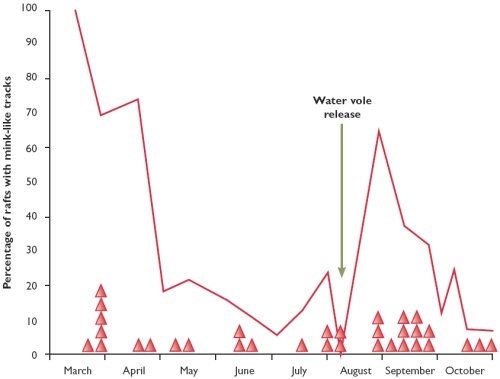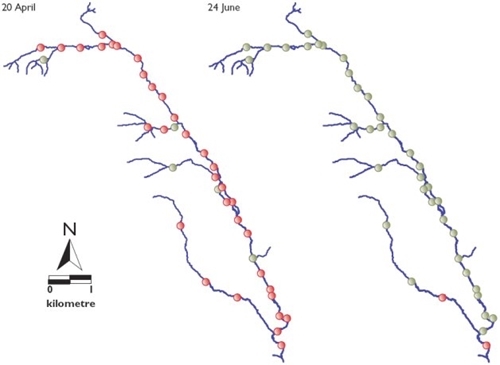Key findings
- High initial mink density on the River Dore, but mink raft technique leads to rapid clearance of mink from the river.
- 300 captive-bred water voles released once river was clear of mink.
- Mink reinvasion during autumn dispersal rapidly contained, and probably caused minimal predation on released voles.
When the fisheries-inspired River Monnow Project (see Review of 2003, page 98) finished in June 2006, it had restored river-bank habitat along 64 kilometres of the rivers forming the upper Monnow catchment in Herefordshire. Livestock had been fenced back, trees had been selectively coppiced to break up the ‘tunnel’ canopy, and lush ground vegetation once again flourished on the river banks. In terms of larger wildlife, though, the riverbanks remained barren.
Where were the water birds? Where was dear old Ratty? Like the fish, these had probably been victims of long-term degradation of the Monnow’s riverside habitats. But at the same time another curse had appeared in the form of American mink. The drastic impact of mink on water voles nation-wide seems beyond doubt. We have much less idea about the impacts of mink on other riparian wildlife species.
Water voles had last been seen in the upper Monnow catchment in 1998. We put a proposal to Defra to re-establish them artificially through the release of captive-bred animals. This would of course have been foolish without first clearing the area of mink, so the plan brought together our own mink control techniques using our GWCT Mink Raft, and the expertise of our collaborator Derek Gow in captive-breeding water voles for subsequent release. These were both well-developed strategies and we were confident that we could make this project work. It would then serve as a demonstration of how to restore water voles to catchments where they had been lost.
Figure 1: Mink detection and capture on the River Dore in Herefordshire, 2006

We chose to concentrate on the most suitable of the Monnow tributaries, the relatively sedate River Dore. With its tributaries this made up about 40 kilometres of water. We constructed mink rafts in January 2006 and placed them on the river in March at one-kilometre intervals.
On the rivers of Hampshire and Wiltshire where we developed the rafts, it was typical to find mink on 30% of rafts at the first inspection. On the Dore, virtually all rafts picked up mink signs during the first month, suggesting a much higher mink density and a greater challenge. But the raft system works and by mid-June, after 13 mink had been killed, on only two rafts towards the lower end of the river did tracks indicate that mink were still locally present (see Figures 1 and 2).
Meanwhile, Derek Gow’s water voles were producing large numbers of young. These were released in late July/early August as juveniles close to breeding weight, mimicking natural events. On the river bank, sibling groups were housed together in open fronted cages, where they were fed regularly until they dispersed of their own accord. For most groups this happened within a week. There were no predation incidents before release, so around 300 voles dispersed along the lush late-summer river banks.
Figure 2: Mink rafts on the River Dore in April and June 2006

Initial clearance of mink from the River Dore was very rapid. In the eight weeks between these two maps, all but two rafts had ceased recording mink tracks, owing to the capture of 13 mink.
In late summer, mink families too break up and disperse, leading to a sudden influx of mink to any control zone. On the Dore, this was quite dramatic, again suggesting a high density of mink in surrounding catchments. Within a fortnight of releasing the voles, the number of rafts with mink signs rose from zero to 26 (out of 40). We shortened our raft-checking regime to ensure that incoming mink were swiftly detected and removed and, reassuringly, none of them proved to have water vole remains in its intestines. These mink appeared to have entered the Dore from downstream.
Winter is a period of relative inactivity for water voles, and we don’t really expect much sign of them until after they have bred in spring. However, we are confident that come spring they will breed, provided we maintain the river corridor free of mink.